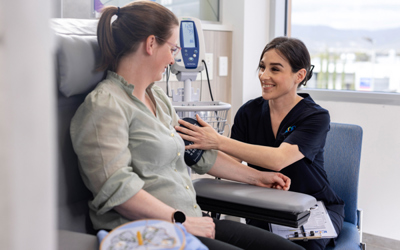Quick facts about liver cancer
The most common type of primary liver cancer is hepatocellular carcinoma (HCC) or hepatoma. HCC starts in the hepatocytes, which is the main liver cell
Approximately 2,800 people in Australia are diagnosed with primary liver cancer each year. Almost three times more men are affected by liver cancer than women
Primary liver cancer is different to secondary (or metastatic) liver cancer, which refers to a cancer that started somewhere else in the body and has spread to the liver
Types of liver cancer
There are three different types of primary liver cancer, which include:
-
Hepatocellular carcinoma
Hepatocellular carcinoma (HCC), also known as hepatoma, is the most common type of primary liver cancer. HCC is a liver cancer which starts in the main liver cells, called hepatocytes. It occurs most often in people with an underlying or long-term liver disease.
-
Cholangiocarcinoma
Cholangiocarcinoma, also known as bile duct cancer, is a type of liver cancer which develops in the cells lining the bile ducts. These bile ducts connect the liver to the bowel and gallbladder. Cholangiocarcinoma is less common than HCC, making up 10-15% of primary liver cancer diagnoses worldwide.
-
Angiosarcoma
Angiosarcoma is an uncommon liver cancer which starts in the blood vessels. This liver cancer is very rare and is more likely to occur in people over 70.
Signs and symptoms of liver cancer
Liver cancer can be difficult to detect early, as most people don’t show any signs and symptoms in its early stages. Signs and symptoms of liver cancer are more likely to appear in later stages of the disease as the cancer grows. This is why it’s important to see your GP or healthcare professional if you experience any of the symptoms below. Discussing anything concerning as soon as possible can help give you peace of mind and offer the best chance of successful treatment if you receive a liver cancer diagnosis.
Symptoms may include:

Weakness and tiredness

Pain in the upper right side of the abdomen

Severe pain and/or swelling of the abdomen

Appetite loss and feeling sick

Weight loss

Yellowing skin and eyes

Pale bowel motions

Darkening of urine

Fever
Stages of liver cancer
The TNM staging system is used to stage liver cancer and define what your cancer looks like.
People with Hepatocellular carcinoma cancer often have liver cirrhosis as well. Prognosis can be affected by either of these conditions, so a hybrid staging system called The Barcelona Clinic Liver Cancer (BCLC) is used in liver cancer as it includes both the cancer size and extent, as well as the degree of liver dysfunction.
A Child-Pugh score helps your doctor to better understand how liver cancer is impacting your ability to carry on daily life.
The Child-Pugh score is defined as:
Child-Pugh A – The liver is working well and cirrhosis is less advanced
Child-Pugh B – The liver is working moderately well
Child-Pugh C – The liver is not working well and cirrhosis is advanced.
BCLC Staging System
-
Stage 0 (very early)
There is a single tumour less than 2 cm in size. The Child-Pugh score is Child-Pugh A.
-
Stage A (early)
There is a single tumour greater than 2 cm in size or up to three tumours less than 3 cm. The Child-Pugh score is Child–Pugh A or B.
-
Stage B (intermediate)
More extensive than Stage A but the cancer is still confined to the liver. The Child-Pugh score is Child-Pugh A or B.
-
Stage C (advanced)
The tumour has grown into one of the main blood vessels of the liver, or spread to the lymph nodes or other body organs. The Child-Pugh score is Child–Pugh A or B.
-
Stage D (end-stage)
The tumour is any size. The Child-Pugh score is Child-Pugh C.
Treatment for liver cancer
There are many different types of treatment for liver cancer. Your treatment will depend on you and your cancer.




